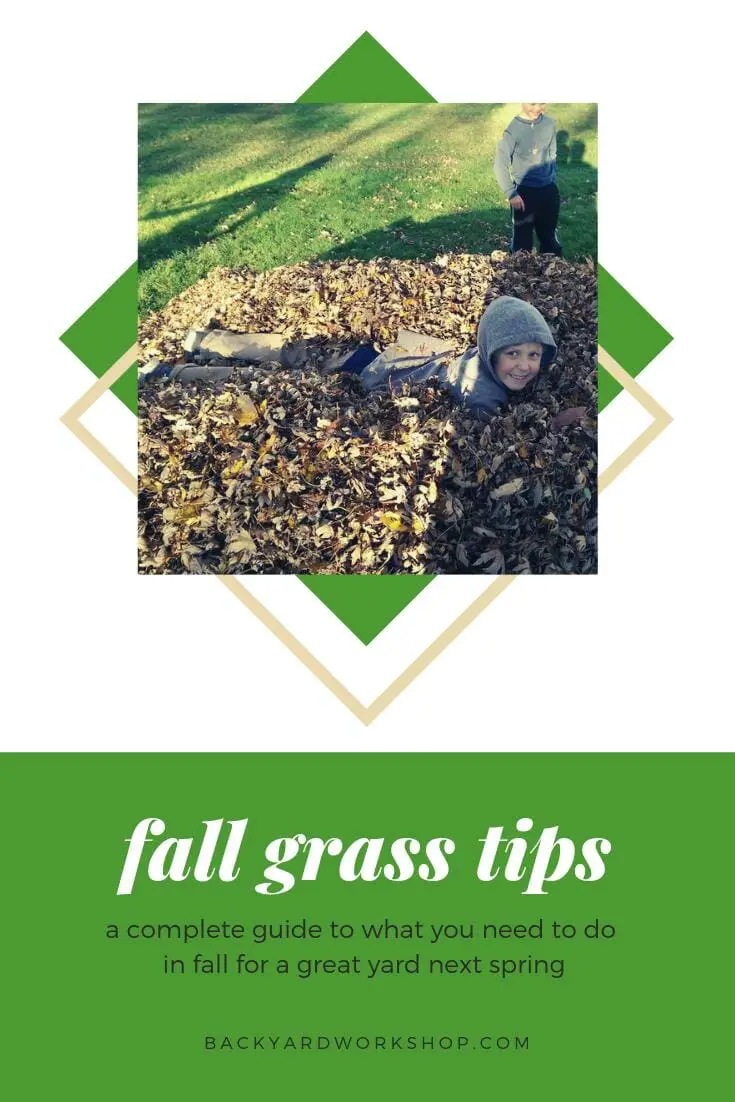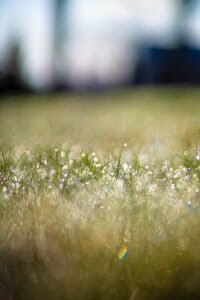Follow These Fall Grass Tips For An Awesome Yard Next Sumer

Fall is probably the most crucial season for lawn care. It’s the time to restore poor quality lawns, to establish new lawns, and to get rid of weeds and the problematic thatch. It’s the best season for lawn fertilization and to prepare the grass for Winter and new growth in Spring.
How you treat the lawn in Fall determines the kind of yard you’ll have next year. In this article, we talk about a few points to consider for Fall grass care. Variety of grass and climate play as an essential a role during Fall as during the other seasons.
What Variety of Grass Do You Have?
Cool-season grasses, also known as northern grasses grow best during colder months of Fall and Spring. It may brown and stay dormant throughout cold winters, but it’s sturdy enough to survive. In the transitional zones, where the winters aren’t so frigid that the ground freezes, the lawn could stay green despite the weather. Fall is the optimum time to plant cool-season grasses.
Southern grasses or warm-season grasses prefer the hot, dry summer to cold winters. It grows from early Spring through summer to Fall and is usually dormant in Winter.
How To Control Weeds?
Previous application of pre-emergent herbicides during Spring and Summer should decrease weed growth in Fall. Pre-emergent herbicides decrease germination resulting in less weed growth.
The best time to use post-emergent herbicides to control weeds is during Fall when the plants store nutrients in the roots. Apply the herbicides on the leaves to kill it or use systemic herbicides that absorb the poison into the plant.
Selective herbicides kill a particular type of weed whereas non-selective herbicides can kill the grass too. Use non-selective herbicides on specific areas where weeds grow abundantly. Be careful that it doesn’t come in contact with the lawn.
September-October is the best time to get rid of the dandelion and clover weeds. A broadleaf herbicide should effectively inhibit the spreading of dandelions on the lawn. Alternatively, for a more natural solution, pick the dandelions for a salad. They are a wonderful source for Vitamin A, C, and K in your diet.
Overseeding In Fall
Fall is the best time for overseeding bare patches and to thicken the lawn.
The weather is perfect for it. It’s not as hot and dry as during the summer and nights are cool but not cold. The soil is warm and moist enough for germination and established growth before the Winter cold.
Keep in mind that the seed must reach and penetrate the soil to be effective. It could be a cumbersome process when overseeding on an established lawn.
Should I Use Fertilizer? If so, What Type?
Fall is the most critical time of the year to fertilize the lawn. If you fertilize only once a year, then it should be in Fall – preferably early Fall. Grass continues to grow during Fall, and for cool-season grasses, it’s the main growing season. Using lawn fertilizer in Fall gives the grass nutrients to grow the roots. Late Fall lawn fertilizing improves the green color during the winter and provides the nutrient for early growth in Spring.
Lawn fertilizer may help the cool-season grasses recover from the Summer heat and prepare for the Winter. Mid October to November should be the deadline for fertilizing the lawn; it’s late enough for the last spurt of growth before the ground freezes. Consider the frost dates for your region to determine when to stop fertilizing in late Fall. It’s safe to fertilize 2-3 weeks before the frost date.
Early Fall fertilizing should have an N-P-K ratio of 3:1:2 or 4:1:2. A fertilizer bag that contains 21% or 32% nitrogen should have 7-8% phosphorus and 14% or 16% potassium. Be mindful that fertilizing too early in the season may cause snow mold in Spring and increase possible Winter damage.
At the end of Fall apply lawn fertilizer high in potassium. It stimulates nutrient absorption and strengthens the grass for the coming Winter. Cool-season grasses will benefit from this late in the season fertilizing. Warm-season grasses, however, are dormant during the Winter and require potassium during its growth season in Spring.
Avoid using nitrogen fertilizer if your grass tends to suffer from snow mold. Snow mold is a fungal disease that shows up as pink and gray grass leaves; the grass looks look dead and unhealthy in snow mold patches. Usually snow mold disappears during the warmer seasons but fertilizing during the Fall may stimulate the fungal growth.
What type of fertilizer should you use?
- New lawns need a higher ratio of phosphorus than nitrogen found in starter fertilizers. Phosphorus stimulates root growth.
- Lawn maintenance fertilizer contains minimum phosphorus and high ratios of nitrogen. Often the soil contains enough phosphorus for the established lawn, and an N-P-K ratio with zero phosphorus is sufficient.
Soil erosion correlates with the density of the lawn. Low coverage increases soil erosion and leads to phosphorus and other nutrient depletion.
What is the Best Grass Mowing Height?
Fall is the growing season for cool-season grass and therefore almost weekly mowing would be necessary. The grass height varies between 2 ½ to 4 inches, depending on the grass type.
Best practice is to cut no more than 1/3 of the grass blade at a time. In other words, when the grass is about 3¾ high, it’s time to mow the lawn. For easy reference, draw a grass mowing height on the lawn mower as a measurement. Just measure the grass length against the mark, and you’ll know if it’s time to mow the lawn.
Mowing the lawn stimulates grass growth. If grass leaves are cut too short, however, the grass won’t be able to sustain itself. The result is weak grass that is prone to diseases and a thin lawn that doesn’t look good.
Before the winter, however, for the last two cuttings, cut the lawn shorter. Set the lawn mower blades at its lowest. It will have the opposite effect as what you desire in the Summer. The goal is to decrease the browning of grass by allowing the sun to reach the soil and the crown of the grass.

Water Amounts and Timing?
Fertilizing and watering the lawn affect each other. The more you water the yard, the more fertilizer the grass needs. Some fertilizers require soaking before applied. Granular fertilizers break down and dissolve when moistened.
Although the weather is cooling, and the soil isn’t as dry as during Summer, the lawn may require watering during the Fall. An inch water per week should suffice. It may mean watering only once or twice per week and not as regular as during the Summer months, but the lawn still needs the moisture.
Water until the end of October would keep the grassroots hydrated throughout the Winter.
What About Leaves and Aeration?
Raking leaves are essential for a healthy lawn. Fallen leaves may block sunlight from reaching the grass. Trees with smaller leaves won’t do as much harm as large leafed trees. Cool season grass thrives during Fall. If it doesn’t receive enough sunlight, however, it cannot grow.
In addition to tidying the lawn by removing fallen leaves, deep raking controls thatch build-up. If the thatch layer is too think (half an inch or more), it causes a barrier between the grass leaves and roots. The thatch-wall blocks the water, nutrients, and air from reaching the grassroots.
Thatch build-up creates an environment for insect plagues and diseases too.
Mulching lawn mowers may be the alternative for removing the leaves. It grinds the leaves to smaller pieces and serves as a natural fertilizer.
Soil compaction is commonly found in lawns with high traffic. The soil is so densely packed it cannot breathe and blocks movement of nutrients and water to reach the plant and its roots. It may inhibit the lawn’s root system to grow, but hardier kind of weeds thrive in this type of soil. A simple way to test for soil compaction is to see if you can push a garden fork 2 inches into the dirt. If not, then aeration is required.
Aeration helps the soil to breathe again when it loosens and breaks down the compact soil. The best time to aerate the lawn is after the second time you’ve mowed the lawn.
Final Preparation for Winter
Heat stimulates snow mold growth. Clean the lawn and rake leaves before the snow starts falling. Debris, sticks, and leaves left on the lawn may form a protected heat environment for snow mold to grow.
Keep on mowing the lawn throughout Fall until the grass stops growing. The last cut should leave the grass height at 2 ½ inches. Too long grass blades could be matted down creating an unhealthy environment.
Continue watering the lawn. The roots should be hydrated for the winter and initial growth during early Spring. Combine with a slow release lawn fertilizer at the end of Fall, and the grass has the protection to survive the Winter.
To prevent broken grass blades in Spring, be careful when walking across frosty lawns. Winter lawns tolerate less traffic and are easier damaged under the snow and frost.

